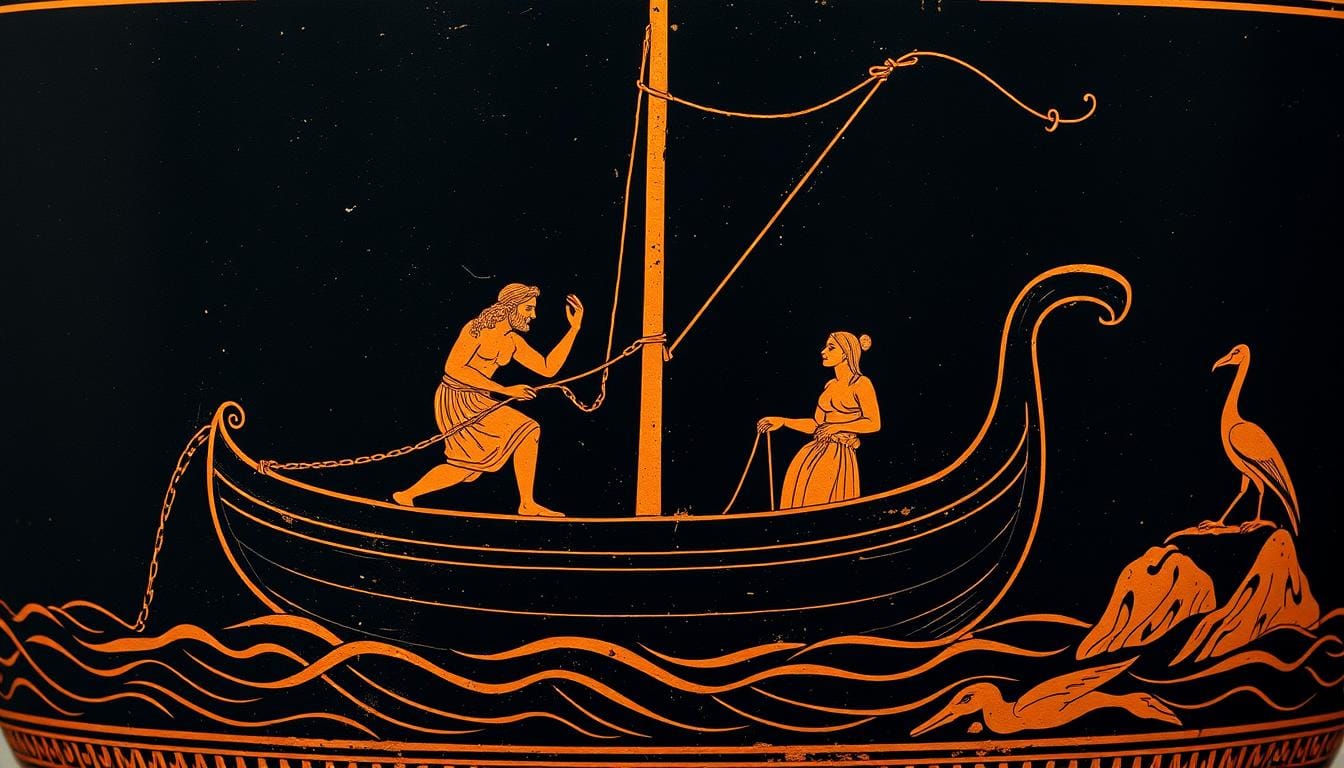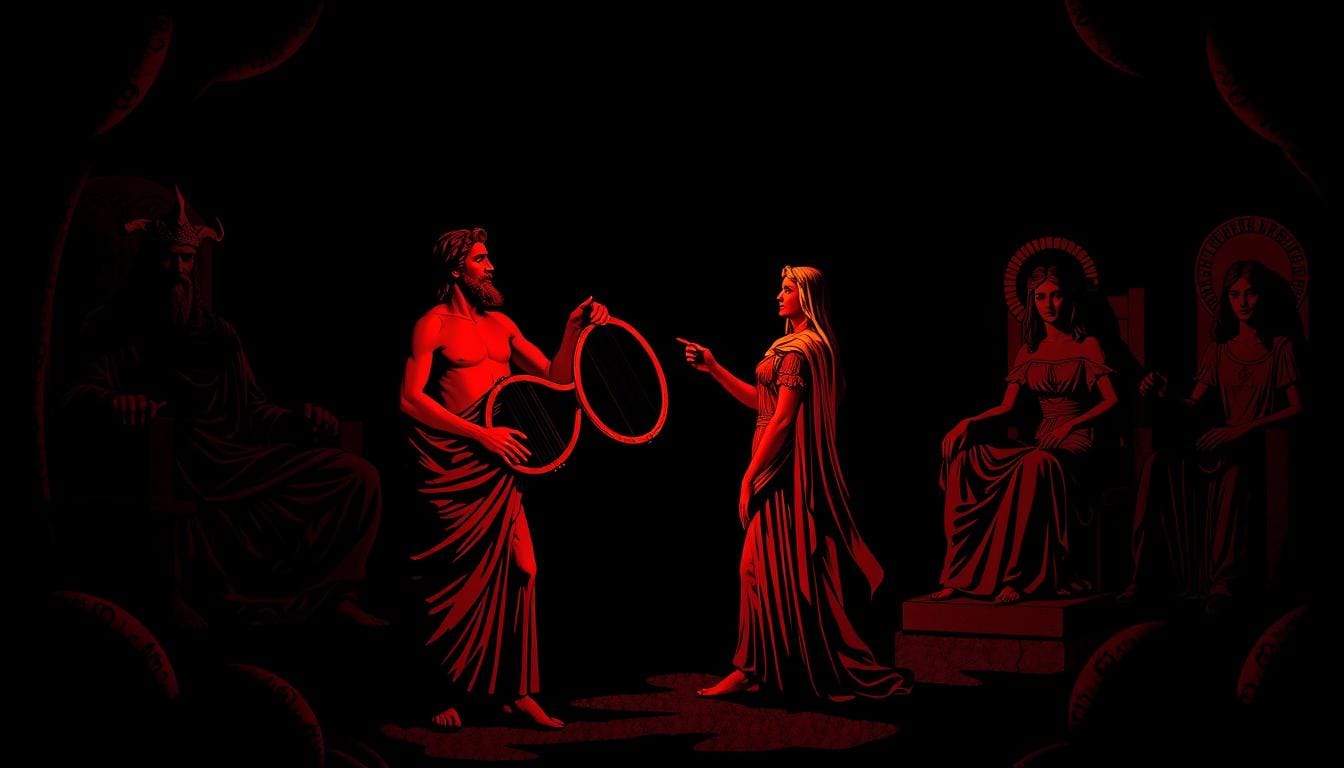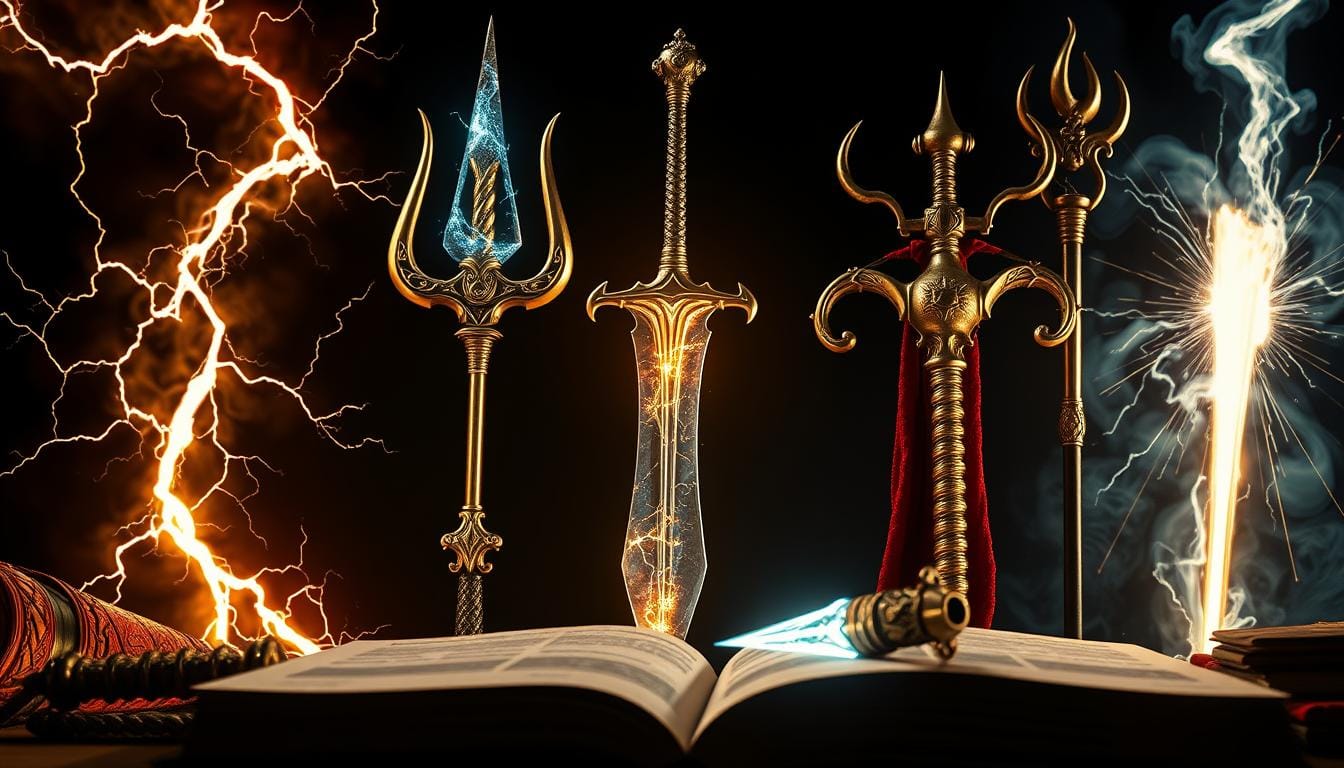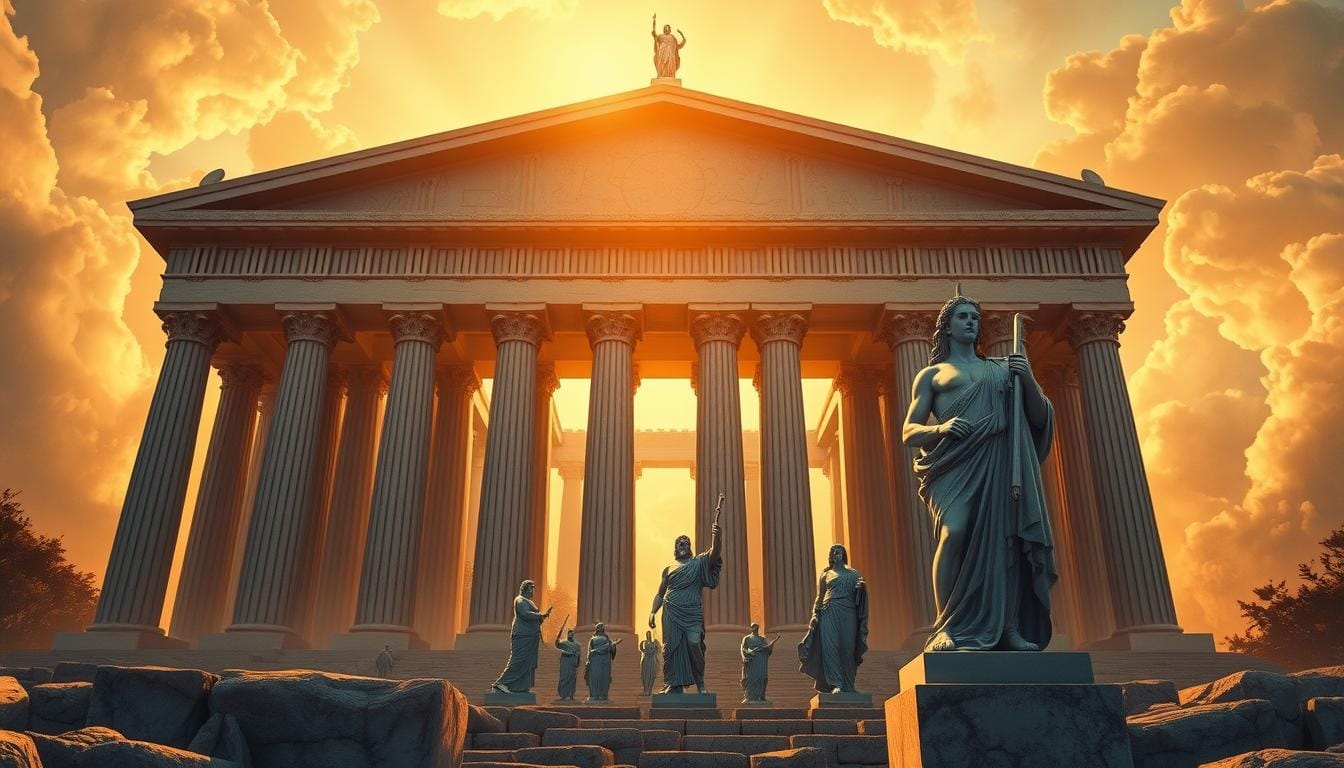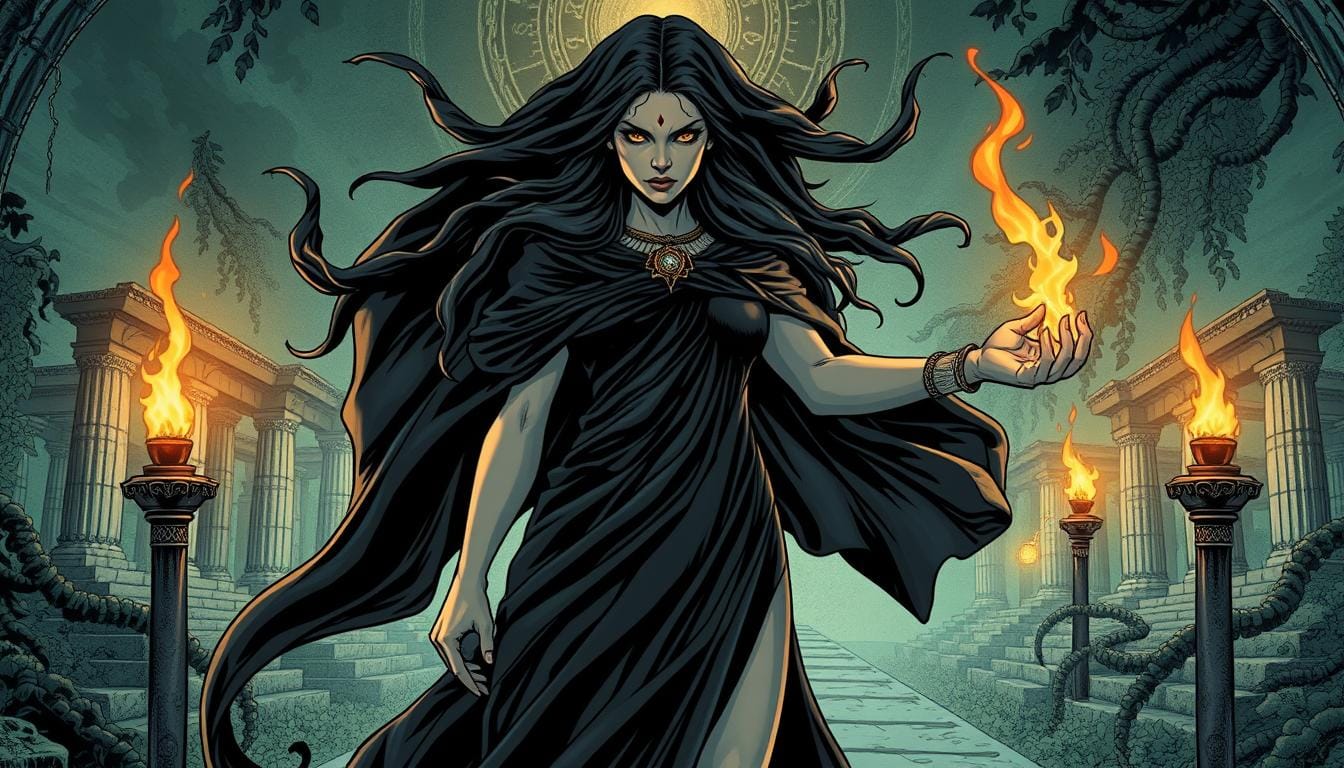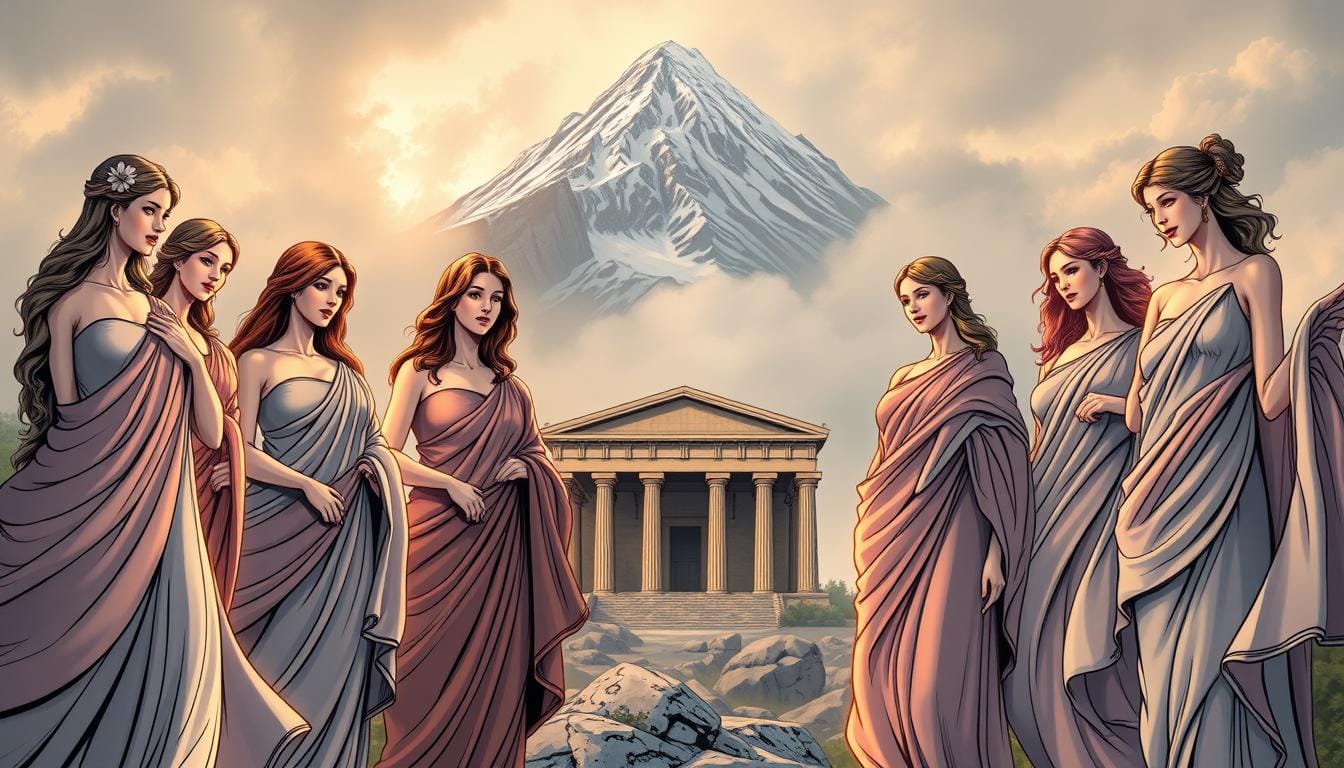More than 2,500 years ago, the ancient Mediterranean had more temples for one deity than almost any other. This goddess was worshipped from Spain to Turkey. Her followers felt both deep devotion and fear.
In Greek mythology, this goddess is one of the most complex and intriguing. She roamed wild forests with her nymphs. Her silver arrows could kill or heal. Poets like Homer saw her as both a protector and a destroyer.
Artemis was Apollo’s twin sister, playing both roles. She was a guardian of women in childbirth and a fierce huntress. This mix made her a compelling figure in ancient religion.
Her impact went beyond ancient Greece. The Romans knew her as Diana. Her stories continue to inspire today, with her independence and strength being key.
Key Takeaways
- Artemis was one of the most widely worshipped deities in the ancient Mediterranean world
- She embodied dual roles as both protector of women and fierce huntress of the wilderness
- Her eternal virginity and independence made her unique among Greek mythology figures
- Ancient poets portrayed her as having the power to bring both blessing and destruction
- Her Roman equivalent Diana shows her lasting influence across different cultures
- She commanded respect from both mortals and fellow gods in ancient stories
Overview of Artemis and Her Significance
The ancient Greeks saw Artemis as a key deity, worshiping her across the Mediterranean. Her temples and shrines were found from Athens to Asia Minor. This shows her big impact on ancient society and religion.
As Zeus’s daughter and Apollo’s twin, Artemis was special among the gods. Her divine background gave her great power. The Goddess of the Hunt was respected by all.
Divine Origins and Family Connections
Artemis was born in a dramatic story that shaped her. Her mother Leto faced Hera’s jealousy during pregnancy. Artemis was born first and helped deliver her twin brother Apollo.
This early role made her protective of women in childbirth. Her family ties also made her a powerful figure in nature and human life.
Position Among the Olympian Deities
Artemis mythology shows her as one of the twelve main Olympian gods. Her power and wide worship earned her this place. The ancient Greeks saw her as a very powerful deity.
Her role was different from other female Olympians. While Hera was about marriage and Aphrodite about love, Artemis chose to remain a virgin. This showed her independence and rejection of traditional roles.
Artemis had a big impact on mortal lives. She could bring both good fortune and harm. Her arrows could kill women, but she also protected them during childbirth.
Sacred Bond with the Natural World
Artemis was deeply connected to nature and wilderness. The ancient Greeks called her the “Mistress of Animals.” She controlled wild animals, forests, and sacred groves.
Her domain included mountains, springs, and remote areas. These places were her sanctuaries where people could seek her favor. She showed both the nurturing and dangerous sides of nature.
Sacred animals followed her everywhere. Bears, deer, and hunting hounds were her companions. This showed her role as a protector of wildlife and the wilderness.
The Goddess of the Hunt balanced civilization and wild nature. She taught humans to respect nature while meeting their needs. Her worship promoted sustainable hunting and respect for animals.
Symbols Associated with Artemis
The ancient Greeks knew Artemis through powerful symbols. These Artemis symbols were found in temples, artwork, and ceremonies. Each symbol had deep meaning, connecting people to her divine power.
Artemis showed her power through special attributes. These symbols told stories of her hunting, lunar connection, and protection. Knowing these Artemis attributes helps us see how ancient people saw her.

The Bow and Arrow
The golden bow was Artemis’s most famous symbol. The Cyclopes made it for her. Her silver arrows could bring death or plague to those who angered her.
Artists often showed Artemis drawing her bow perfectly. The bow showed her skill as a huntress and her role in fate. No arrow ever missed its target when shot by her.
Her quiver was always full of arrows. These arrows showed her ability to strike from far away. The bow also showed her independence and self-reliance in the wild.
The Moon
Artemis was connected to the moon, like other lunar gods. Artists often showed her with a crescent moon crown. This symbol linked her to night and monthly cycles.
The moon was her guide in darkness. Hunters and travelers called on her at night. Her lunar side was also tied to women’s mysteries and natural cycles.
Silver was sacred to Artemis because of its moon-like color. Her arrows shone with silver light, showing her celestial side. The moon’s phases mirrored her changing roles and moods.
Sacred Animals
Deer were very important to Artemis symbols. They pulled her chariot across the sky. She often wore deer-skin capes or hunted with them.
Bears were symbols of her fierce protection. Young girls were called arktoi (little bears) in her temples. Bears represented the wild, untamed nature she governed.
Various birds were her messengers. Quails and guinea fowl lived in her sacred groves. These birds connected her to earth and sky.
| Symbol Category | Specific Items | Symbolic Meaning | Cultural Significance |
|---|---|---|---|
| Weapons | Golden bow, silver arrows, quiver | Hunting skill, divine justice | Appeared on coins and temple art |
| Celestial | Crescent moon, silver light | Lunar cycles, nighttime guidance | Connected to women’s rituals |
| Animals | Deer, bears, quails | Wilderness mastery, protection | Featured in religious ceremonies |
| Plants | Cypress trees, amaranth flowers | Eternal life, sacred groves | Planted around temple grounds |
Cypress trees grew in her sacred groves. They symbolized eternal life and connection to the underworld. Amaranth flowers never faded, showing her constant nature.
These Artemis attributes were seen in Greek art and literature. They helped people recognize the goddess and understand her powers. Each symbol showed her importance as a major Olympic deity.
The Duality of Artemis
Artemis is a goddess of Greek mythology with striking contrasts. She was fiercely independent yet showed deep compassion. Her character was complex, making her a standout in ancient stories.
The ancient Greeks saw no problem with these opposing traits. They believed true feminine power could take many forms. Artemis showed the full range of womanhood, from a warrior to a caregiver.
Fierce Hunter and Wilderness Warrior
As the goddess of the hunt, Artemis was unmatched in skill and precision. She roamed forests with her silver bow and hunting hounds. Her arrows always hit their target, and she punished those who harmed nature.
Her stories are filled with her wrath. She turned Actaeon into a stag for seeing her naked. She also demanded Iphigenia’s sacrifice, showing her power.
Her eternal virginity showed her complete autonomy. Unlike other goddesses, Artemis chose to be independent. This was seen as strength, not weakness, in ancient Greece.
Gentle Guardian of the Vulnerable
Despite her fierce image, Artemis was also a protector of young ones. She watched over girls becoming women. Her gentle side was most evident in her role in childbirth and midwifery.
She worked with Eileithyia and Hera to ease labor pains. She healed diseases affecting women and children. This made her a beloved figure among mothers and daughters in Greece.
The Brauronia festival celebrated her nurturing side. Young Athenian girls were called “arktoi” or little bears in her honor. These ceremonies marked their transition to adulthood under her care.
| Aspect | Hunter Role | Protector Role | Symbolic Meaning |
|---|---|---|---|
| Primary Function | Wilderness guardian | Child nurturer | Complete feminine power |
| Key Attributes | Bow, arrows, hounds | Healing herbs, midwifery | Independence and care |
| Worshipper Focus | Hunters, warriors | Mothers, young girls | All seeking protection |
| Festival Expression | Hunting competitions | Brauronia ceremonies | Life cycle celebration |
Artemis was uniquely relatable to ancient Greeks. She showed both the wild side of nature and the caring side of motherhood. Her complexity highlighted the many facets of feminine strength.
Major Myths Involving Artemis
Artemis mythology is filled with stories of her miraculous birth and her role in epic wars. These tales show her complex nature and her power in the Greek world. They highlight her as a protective sister and a vengeful deity.

The Birth of Artemis
The birth story of Artemis is a dramatic tale in Greek tradition. Zeus had an affair with Leto, making Hera jealous. Hera then forbade Leto from giving birth on land.
Leto found refuge on the floating island of Delos. Artemis was born first, showing her divine nature. She helped deliver her twin brother Apollo right away.
This myth made Artemis a midwife goddess and protector of women. Her quick help in Apollo’s delivery showed her caring side from the start.
The Story of Actaeon
The story of Actaeon shows Artemis’s fierce protection of her privacy. Actaeon saw the goddess bathing naked, sealing his fate.
Artemis turned Actaeon into a stag, taking away his human form and voice. He fled in terror, unable to call out to his dogs.
His dogs, not recognizing him, chased and killed him. This Artemis mythology tale warns about respecting divine boundaries.
The Trojan War and Artemis' Role
During the Trojan War, Artemis played a key role. King Agamemnon boasted he was better than Artemis, angering her.
Artemis halted the winds to stop the Greek ships. She demanded Agamemnon’s daughter Iphigenia as a sacrifice. This was a heart-wrenching moment.
Artemis sided with the Trojans against the Greeks. She even fought other gods, like Hera. These stories show how personal slights can affect divine actions.
These myths show Artemis’s complex nature and her impact on both divine and mortal realms. Her stories continue to resonate, exploring themes of family loyalty, justice, and disrespecting the natural order.
Worship Practices of Artemis
Artemis’s worship was marked by grand temples, lively festivals, and offerings that lasted for centuries. Her followers engaged in elaborate rituals across the ancient world. These shared rituals united people from different places, creating a sense of community.
The Artemis cult had its own unique traits in various areas but kept the core of honoring the hunt goddess. People adapted local traditions to celebrate her divine nature. This created strong ties between communities and their goddess.
Sacred Sanctuaries and Divine Architecture
The most famous Artemis temple was in Ephesus, known as one of the Seven Wonders. It was a marvel of architecture and art. The temple housed a unique version of Artemis, blending Greek and local traditions.
The Ephesian temple had 127 marble columns, each 60 feet tall. It drew pilgrims from everywhere. Sadly, it was destroyed by fire, leaving only ruins of its former beauty.
Other temples dedicated to Artemis were found throughout Greece. The Brauron sanctuary in Attica was special for young women. These temples were key for community worship and learning.
Seasonal Celebrations and Sacred Festivals
Greek communities held many festivals for Artemis throughout the year. The month Artemision was named after her more than any other deity. This shows how important she was in their lives.
Spring festivals celebrated Artemis’s role in nature’s renewal. The Brauronia festival in Athens featured girls as arktoi or “little bears.” These ceremonies linked them to the goddess’s bear symbolism.
The Artemisia celebrations were widespread, adapting to local customs but keeping key elements. People came together for processions, sacrifices, and feasts. These events strengthened their bonds and devotion.
Sacred Gifts and Ritual Offerings
Worshippers gave various gifts to win Artemis’s favor and protection. They offered honey cakes, fresh flowers, and fruits. These gifts showed her connection to nature’s abundance.
More elaborate sacrifices included animals like deer and goats. Rich devotees gave bronze statues and jewelry for the temples. Some regions kept the tradition of bear-shaped votives, linking to ancient traditions.
The Artemis cult kept elements from earlier goddess worship, like the bear form. This connection showed the continuity of her importance through changing times.
Artemis in Modern Culture
Artemis inspires many today, from stories to art. Her spirit of independence and love for nature is seen in many works. These themes speak to people now, just as they did in ancient times.
Representation in Literature
For centuries, Artemis has been a key figure in literature. Shakespeare often mentioned her, using the name Diana. In Pericles, Thaisa follows Artemis’ sacred order, and Marina seeks her protection.
Shakespeare also told the story of Actaeon, who angered Artemis. He was turned into a stag as punishment. This myth shows the dangers of crossing the goddess.
Today, fantasy novels highlight Artemis as a strong, independent woman. She is a role model for young readers, showing the power of female characters.

Depictions in Film and Television
Artemis has appeared in many films and TV shows. Early movies showed her as a majestic huntress. These images have shaped how we see her today.
Recent movies like the Percy Jackson series have updated her image. TV shows also explore her complex character and values.
Fantasy movies often focus on her archery and moon connection. These stories highlight her role as a hunter and protector, appealing to those who care about the environment.
Influence on Contemporary Art
Artemis inspires many artists today. Painters create beautiful scenes of her with the moon. These works mix old beauty with new messages about nature.
Sculptors make powerful pieces that blend old and new. Digital artists use her symbols to talk about female empowerment and wildlife protection.
Artemis also influences fashion and design. Jewelry and logos use her symbols to show strength and harmony with nature.
Comparisons with Other Deities
Ancient cultures across the Mediterranean had moon goddess figures like Artemis. These goddesses were known for lunar worship, hunting, and being independent. They show how people worldwide connected with nature and the moon.
Looking at these similarities helps us see how societies saw similar divine powers. The goddess of the hunt and moon was seen in many cultures. Each culture made these goddesses their own, fitting them into their spiritual and social views.
Artemis and Diana
The Roman goddess Diana is very similar to Artemis. The Romans took Greek gods and made them their own. Diana kept Artemis’s main traits but also got some unique Roman qualities.
Diana was very important in Rome, with a special place on the Aventine Hill. Her grove near Lake Nemi was a big pilgrimage site. People in Campania also loved her, building many temples for her.
Later, Roman writers linked Diana with Selene, the Moon. This made Diana even more important as a moon goddess. Diana became a complex figure, blending the moon and earth.
Parallels with Other Lunar Goddesses
Many ancient moon goddess figures were similar to Artemis. Hecate from Greece was known for lunar magic and crossroads. The Anatolian Cybele controlled moon cycles and wild nature.
In Celtic mythology, Arduinna was a huntress goddess of the Ardennes forest. The Germanic tribes had Abnoba, who protected hunters and forest animals. These goddesses show how Indo-European cultures shared similar divine figures.
The many goddesses with bows show deep human needs. They stood for feminine independence and natural wisdom. These goddesses were spiritual guides for women, showing them how to be free and connected to nature.
| Deity | Culture | Primary Domains | Sacred Symbols |
|---|---|---|---|
| Artemis | Greek | Hunt, Moon, Childbirth | Bow, Deer, Cypress |
| Diana | Roman | Hunt, Moon, Crossroads | Bow, Hound, Oak |
| Selene | Greek | Moon, Night, Dreams | Crescent, Chariot, Bulls |
| Hecate | Greek | Magic, Moon, Crossroads | Keys, Torch, Serpent |
These studies show how ancient people saw the divine feminine. The moon goddess idea was universal but also changed to fit local needs. This flexibility explains why similar goddesses were found across different places and times.
The Psychological Interpretation of Artemis
Artemis is seen as a symbol of human independence and natural instinct through a psychological lens. She is more than just an ancient deity. She represents deep aspects of the human psyche that are relevant today.
Being one of the three major virgin goddesses, alongside Athena and Hestia, holds deep psychological meaning. It’s not about sexual repression or fear of intimacy. Instead, it symbolizes complete personal sovereignty and the refusal to be defined by others.
Archetype of the Independent Woman
Artemis is the archetype of the truly independent woman who doesn’t need external validation. She was immune to Aphrodite’s power, showing aspects of human nature that can’t be conquered by love or social pressure.
This independence isn’t from rejection or trauma. It’s from a complete sense of self that doesn’t need external completion. Artemis chose her path and defended it fiercely.
In psychological terms, she represents valuing autonomy over conformity. She shows that true strength comes from knowing who you are and refusing to change for others.
Her eternal maidenhood symbolizes keeping one’s essential self intact. It shows the psychological state where personal power isn’t diluted by the need to please others.
Connection to Nature and Instinct
The psychological interpretation of Artemis shows her deep connection to humanity’s primal instincts. She represents the wild, untamed aspects of human nature that resist civilization’s constraints.
Her role as goddess of the hunt connects to our basic survival instincts. She embodies the part of us that remains alert and ready to act when needed. This isn’t about violence, but about staying connected to our natural awareness.
Artemis also represents the fierce protective instinct that emerges when defending what we hold dear. Her dual nature as both nurturer and destroyer reflects the complexity of maternal instincts and protective love.
In modern psychology, she symbolizes the importance of maintaining our connection to nature and intuition. She reminds us that civilized behavior shouldn’t mean losing touch with our natural wisdom.
Her psychological legacy teaches us that true independence requires both strength and sensitivity. Like Artemis, we can be both gentle protectors and fierce defenders of our values and boundaries.
Lessons from the Myth of Artemis
Artemis teaches us about strength, independence, and our bond with nature through her stories. Her tales show both her caring and fierce sides. These myths inspire us to grow personally and care for the environment.
The goddess was seen as “free nature” by the early Greeks. They admired wild spaces and independent spirits. Her stories guide us today, helping us face modern challenges.
Empowerment and Strength
Artemis shows that true strength is knowing your values and standing by them. She refused to give in to other gods’ demands. Her story teaches us to set our own boundaries.
She protected her followers and sacred places with determination. This shows that empowerment means protecting others, not just ourselves.
Artemis could bring death with her silver arrows for breaking her laws. This dark side shows the importance of defending our values. It teaches us to act decisively when our values are at risk.
Respect for Nature and Wildlife
Artemis’ bond with wild animals teaches us about caring for the environment. She watched over forests, mountains, and all creatures. Her story reminds us to protect wilderness today.
The ancient Greeks saw Artemis as the untamed spirit of nature. She taught them to respect wildlife and keep wild places safe. Today, her example urges us to fight for environmental protection.
Her myths show that humans and nature can live together with respect. Artemis welcomed those who honored her domain. She punished those who disrespected it.
These stories urge us to find our gentle and fierce sides. Like Artemis, we can care for others while defending what’s important. Her legacy teaches us that freedom comes from personal strength and respect for nature.
Conclusion: The Enduring Legacy of Artemis
The ancient goddess Artemis has captured hearts for centuries. She shows that myths can live on forever. Her bravery and love for nature inspire people today who look for real role models.
Relevance in Today's Society
Artemis stands for values that matter today. She fights for those who are weak, just like today’s fights for women’s rights and saving the planet. She shows us how to care and protect at the same time.
Shakespeare often used Artemis to show female strength and freedom. This tradition keeps going, with artists and writers finding inspiration in her story.
The Continued Inspiration of Artemis
Artemis is seen in books, movies, and art today. She’s a symbol of the independent woman who stands up for her beliefs. This inspires people in their personal and work lives.
Her stories teach us about respecting nature and staying true to ourselves. Artemis reminds us that true strength is about knowing our place and protecting what’s important to us.
